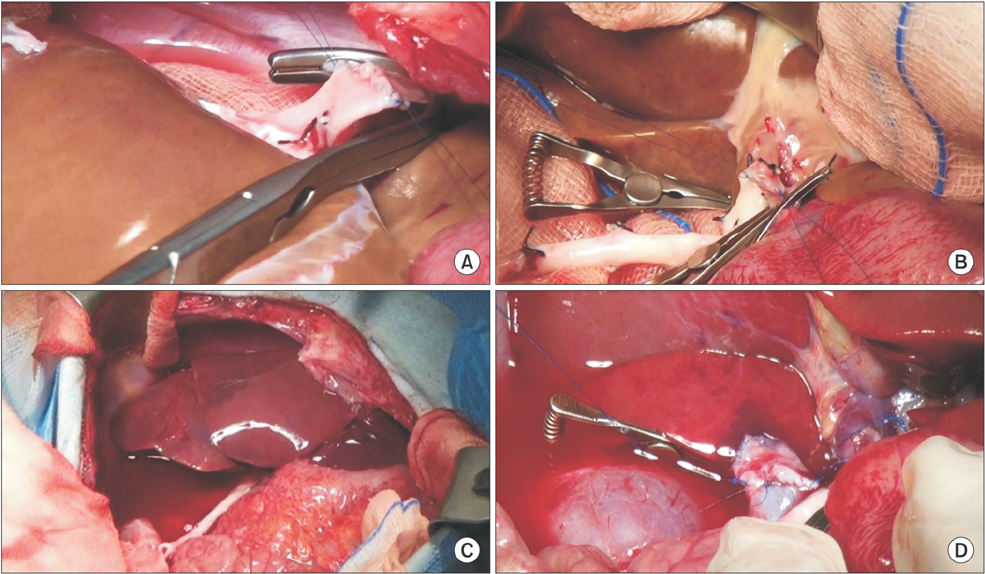Ann Surg Treat Res.
2018 Jan;94(1):8-12. 10.4174/astr.2018.94.1.8.
Technique for orthotopic liver transplantation in cynomolgus monkeys (Macaca fascicularis)
- Affiliations
-
- 1Department of Surgery, Samsung Medical Center, Sungkyunkwan University School of Medicine, Seoul, Korea. kmhyj111@gmail.com
- KMID: 2405333
- DOI: http://doi.org/10.4174/astr.2018.94.1.8
Abstract
- PURPOSE
Recent studies investigating new strategies to modulate the immune system have utilized animal models of liver transplantation (LT). However, the anhepatic phase (AHP) remains a crucial problem in LT. The aim of the present study is to introduce a technique for successful orthotopic LT in cynomolgus monkeys using an early-reperfusion strategy.
METHODS
Orthotopicallo-LT was performed with seven donor/recipient pairs of cynomolgus monkeys.
RESULTS
In 2 recipients, liver allografts were perfused after suprahepatic inferior vena cava (SHIVC), portal vein (PV), and infrahepatic inferior vena cava (IHIVC) anastomosis. To reduce the time of AHP in five recipients, liver allografts ware perfused after SHIVC and PV anastomosis while the IHIVC was not anastomosed. In the latter strategy, the AHP was reduced from 46 minutes to 31 minutes and a 24-hour survival rate of 80% was achieved.
CONCLUSION
Our results indicate that an early-reperfusion strategy can be successfully used to establish a LT model in cynomolgus monkeys with a consistently high rate of animal survival.
Keyword
MeSH Terms
Figure
Reference
-
1. Kawai T, Leventhal J, Madsen JC, Strober S, Turka LA, Wood KJ. Tolerance: one transplant for life. Transplantation. 2014; 98:117–121.2. Nomura M, Yamashita K, Murakami M, Takehara M, Echizenya H, Sunahara M, et al. Induction of donor-specific tolerance by adenovirus-mediated CD40Ig gene therapy in rat liver transplantation. Transplantation. 2002; 73:1403–1410.3. Oura T, Yamashita K, Suzuki T, Fukumori D, Watanabe M, Hirokata G, et al. Long-term hepatic allograft acceptance based on CD40 blockade by ASKP1240 in nonhuman primates. Am J Transplant. 2012; 12:1740–1754.
Article4. Yamada Y, Boskovic S, Aoyama A, Murakami T, Putheti P, Smith RN, et al. Overcoming memory T-cell responses for induction of delayed tolerance in nonhuman primates. Am J Transplant. 2012; 12:330–340.
Article5. Levitsky J. Operational tolerance: past lessons and future prospects. Liver Transpl. 2011; 17:222–232.
Article6. Shah JA, Navarro-Alvarez N, DeFazio M, Rosales IA, Elias N, Yeh H, et al. A bridge to somewhere: 25-day survival after pig-to-baboon liver xenotransplantation. Ann Surg. 2016; 263:1069–1071.7. Oura T, Yamashita K, Suzuki T, Watanabe M, Hirokata G, Wakayama K, et al. A technique for orthotopic liver transplantation in cynomolgus monkeys. Transplantation. 2014; 98:e58–e60.
Article8. Spetzler VN, Goldaracena N, Knaak JM, Louis KS, Selzner N, Selzner M. Technique of porcine liver procurement and orthotopic transplantation using an active porto-caval shunt. J Vis Exp. 2015; (99):e52055.
Article9. Allen AM, Kim WR, Therneau TM, Larson JJ, Heimbach JK, Rule AD. Chronic kidney disease and associated mortality after liver transplantation: a time-dependent analysis using measured glomerular filtration rate. J Hepatol. 2014; 61:286–292.10. Fuchs EJ. Transplantation tolerance: from theory to clinic. Immunol Rev. 2014; 258:64–79.
Article11. Kawai T, Sachs DH, Sprangers B, Spitzer TR, Saidman SL, Zorn E, et al. Long-term results in recipients of combined HLA-mismatched kidney and bone marrow transplantation without maintenance immunosuppression. Am J Transplant. 2014; 14:1599–1611.
Article12. Falcini F, Martini E, Marsili M, Benassai C, Fabbri LP, Tanini R, et al. Veno-venous bypass in experimental liver transplantation: portal-jugular versus cavalportal-jugular. G Chir. 1990; 11:206–210.13. Lee KW, Cho CW, Lee JE, Park H, Choi GS, Jeong WK, et al. Morphologic and Doppler findings from hepatic ultrasonography of normal cynomolgus monkeys (Macaca fascicularis). J Am Assoc Lab Anim Sci. 2017; 56:177–180.
- Full Text Links
- Actions
-
Cited
- CITED
-
- Close
- Share
- Similar articles
-
- Reference values of hematological and biochemical parameters in young-adult cynomolgus monkey (Macaca fascicularis) and rhesus monkey (Macaca mulatta) anesthetized with ketamine hydrochloride
- Surgical removal of a telemetry system in a cynomolgus monkey (Macaca fascicularis): a 12-month observation study
- A comparative study on intraocular pressure under various anesthetics in cynomolgus monkeys (Macaca fascicularis)
- Immobilization with Ketamine HCl and Tiletamine-Zolazepam in Cynomolgus Monkeys
- Reference values of clinical pathology parameters in cynomolgus monkeys (Macaca fascicularis) used in preclinical studies



